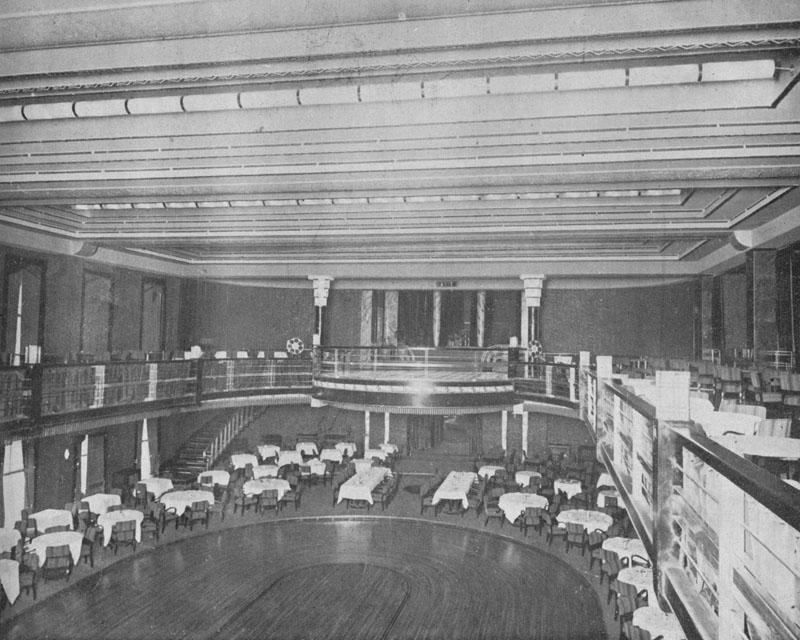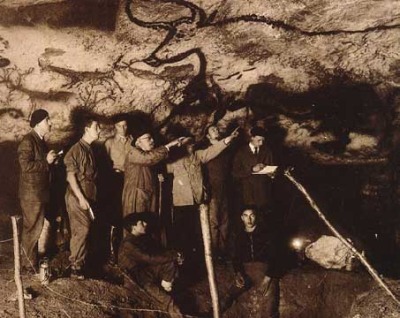
The Marquee of the Paramount Ballroom on the corner of Yuyuan Road and Wanhangdu Road, Shanghai
The other night (Thursday March 17) I took my Global Nightlife students and a few of their friends from the NYU Shanghai program on their second tour of Shanghai’s nightscapes. This time we started at the famed Paramount Ballroom, the finest and most celebrated ballroom of the Golden Age of Shanghai nightlife, the 1930s. The ballroom is the only one from the 1930s that today is still operating as a commercial dance establishment. Though the Paramount ballroom was converted into a cinema during the Mao Years, it was bought up by a Taiwanese investor who dreamed of turning it back into a 1930s-style club that would also fit in with contemporary Shanghai nightlife. The result is that the establishment is divided into two ballrooms. The ballroom on the fourth floor, accessed by elevator at the lobby, features dance “instructors” (young attractive male and female dancers) who dance ballroom-style dances such as the fox-trot, cha cha, and tango with older customers of both sexes to a live “jazz” band. The other space is a disco occupying what was original the main ballroom of the establishment. Here customers can sit with young attractive men and women dressed in 1930s style. The men sport black and white outfits and caps that look like some costume designer’s vague idea of 1930s Shanghai, while the women are all dressed in the famous qipao, that sexy body-hugging garment favored by dance hostesses in that era. The circular stairway leading to the lounge area that faces the disco entrance and the lounge itself are decorated with posters and portraits of leading actresses from the 1930s such as Ruan Lingyu, Zhou Xuan, and Butterfly Wu (Hu Die). There is even a glass case containing colorful, shiny pairs of high-heeled shoes. The result is a phantasmagoric impression of a dream world of modern life that connects today’s Shanghai to the highly nostalgized and imagined era of the 1930s. Even the hostesses (and hosts) are present in both ballrooms--a feature of the old Paramount ballroom revived in a retro form.

Here is one of a number of photos taken of the original Paramount Ballroom for publication in a Chinese architectural journal in the 1930s. I relate in my book Shanghai's Dancing World, this was an ultra-modern ballroom for its time. It was designed to comfortably hold several hundred people on big nights but on nights with fewer people it would still seem like a happening place. The portioning off of the ballroom into many different spaces--dance floor, side areas, bar, private rooms, balcony seating--all connected yet separate and distinct from each other was a key feature of the ballroom's original design-work. Today the main ballroom still has a similar layout to what it was like in the 1930s, though the decor is not nearly as chic. This was one of the hot spots of the 1930s. Not so anymore, though the management is trying hard to gain a steady clientele and they have renovated the club many times since it opened in the early 2000s.
We then headed over to Fuxing Road to visit the JZ Club, one of Shanghai’s top jazz bars. After that we rounded the corner to Yongfu Lu where a new nightlife street has arisen over the past three or four years. We spent some time at a French-owned bar called Rhumerie Bounty, then visited the Apartment next door, and finished the night with a brief tour of the Shelter. Throughout the journey, I asked the students to evaluate the spaces we visited in terms of sociologist Erving Goffman’s distinction between “tight” and “loose” spaces. Tight spaces are highly scripted and rule-bound environments whereas loose spaces allow for a greater range of flexibility and personal freedom. One would imagine that nightlife environments are by their nature “loose” spaces, but in observations of how these spaces are constructed and experienced, one finds that these spaces range between the poles of tight and loose. While some spaces encourage patrons to sit in fixed seating and consume both entertainment and drinks, others are more open-ended and encourage customers to mingle and rub elbows with each other. The JZ Club, the students agreed, was a fairly tight space, with people seated and chatting with their small circle of companions or watching the performance (in this case it was Willow Neilson’s jazz quartet). The Rhumerie Bounty is a bar built around the ghostly theme of a pirate ship--a phantasmagoric journey, voyage, or adventure that my students could relate to through referencing the popular film Pirates of the Caribbean starring Johnny Depp. This space was also relatively tight, with groups of customers gathered at tables made out of barrels, consuming the rum-based drinks that the bar offers. We did the same as we engaged in a communal bonding ritual of toasting with small shot glasses of kiwi and mango flavored rum mixed with shaved ice. While the space may have been “tight” in one respect, within our small circle things were loosening up and the respectable boundaries and hierarchical rigidities between student and professor were beginning to blur. Thus it was fitting that we traveled deeper into the high seas of Yongfu Road nightlife.
The Apartment and Shelter are constructed as looser environments. The Apartment is modeled on the idea of a person’s private loft apartment (though fitted with a large bar), and in addition to easy chairs and a few barstools there is a large bed in the main room for people to lounge about on. But mostly people mill around or dance to the beat of house music in a large open space. After a few minutes of observation it becomes obvious that people in this space are open to casual social encounters with strangers. The “homey” environment lends itself to this open and loose atmosphere, since the club feels like a private house party which suggests that the people invited are open and friendly to interactions since nobody at a house party is a complete outsider, and all are connected in some way to each other (sort of like the facebook phenomenon or any other online social network).
After a quick visit to the Apartment, we moved on to Shelter, and after a bit of convincing we managed to get the students to enter the dark forbidding tunnel into this underground cavern club. Shelter is similar to the Apartment in that it offers a large open space for people to congregate, although on that night there were couches and tables placed in the middle of the club (usually it is left open for dancing). At the end of the hall, a European DJ was spinning techno and trance music, backed by an abstract light display that enhanced the otherworldly environment of the club. Behind the main hall of this former underground bomb shelter are further rooms, which were dark. Armed with a flashlight from a cell phone, we entered the dark chambers and imagined the rituals that might take place in such a space in prehistoric times, when men were painting bulls on the cave walls of Lascaux.

The Hall of Bulls in the Caves of Lascaux
This phantasmagoric, dreamlike experience of nightlife into which one is thrust into dream worlds through the music, art, and design of the clubs, connects with the themes developed by the so-called Frankfurt School of sociologists and urban philosophers. I’ve been rereading David Frisby’s book Fragments of Modernity lately. Frisby analyzes the writings of three German writers (I wish I could read German!) who tackled the complexities of urban modernity in the 19th and early 20th century: Georg Simmel, Siegfried Kracauer, and Walter Benjamin. I am drawn to all of these writers and find their methods and insights useful, if a bit obscure at times. Kracauer is probably the most lucid of the three. Benjamin was smoking a lot of hashish and it probably affected his way of thinking and writing greatly, but out of the mists and clouds of kabbalic obscurity his purpose still shines through. Benjamin, according to Frisby, was obsessed with the Paris Arcades of the 19th century, which resulted in his unfinished and fragmentary magnum opus, The Arcades Project. “Benjamin’s theory of modernity was later to have its source in the prehistory of modernity, one of whose central locations was the Parisian arcades of the earlier part of the nineteenth century. They were to be conceived as the threshold to a primal world of fantasy, illusion and phantasmagorias that expressed the dream world of capitalism.” (Frisby p. 3)
I think that S, K, and B would find the contemporary nightlife culture of Shanghai a fascinating journey into this “primal world of fantasy, illusion and phantasmagorias.” Simmel might relate the sphere of nightlife to his writings on adventure (http://condor.depaul.edu/dweinste/theory/adventure.html), as an experience that falls outside of the wholistic framework of one’s everyday life. Kracauer might discuss the bars and clubs of Shanghai in relation to his observations of the bourgeoisie as written in his essay “On Travel and Dance,” published in a collection of his writings titled the Mass Ornament. He would likely remark that the clubs and bars of Shanghai are faithful reproductions of a global nightlife model that is indistinguishable from city to city around the world. And he would be superficially right, though as James Farrer and I discuss in our forthcoming book Shanghai Nightscapes, globalization can be a deceiving term and much of the club culture is deeply localized and rooted in traditions--or modernizations--particular to Shanghai.
Benjamin would likely relate these spaces to his overarching theory of the dream world of modernity produced by capitalism, as embodied in the 19th century Paris arcades. In both the intro and conclusion to Shanghai’s Dancing World, I discuss Benjamin’s concept of modernity’s dream world, relating his work to the Shanghai-based writer of the same period, Mu Shiying, who also analyzed that fragmentary dream world as it unfolded in this metropolis in short stories such as his famous "Shanghai Fox-trot." Whereas Benjamin’s observations came from Paris (and Berlin), Mu’s study of Shanghai has many interesting parallels, though he was writing in the genre of modernist literature and not sociological observation.